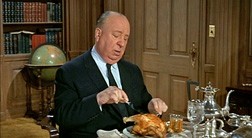Why I Don’t Eat Anchovies
- Share
- Tweet
- Pin
- Share
Recently I ran across a woman who wondered aloud why she saw so few birds in Door County. In response, I assured her that the peninsula has an ample number of birds but, if she wasn’t seeing many, it was probably just because they were staying home in their heated birdhouses or perhaps they were visiting relatives in Georgia while waiting (as we all are) for summer to arrive in Door County.
Whether this conversation was the impetus or not, I spent the next few days reflecting on Alfred Hitchcock’s famous movie The Birds.

Director Alfred Hitchcock eats a bird in a still from a trailer for his 1963 thriller “The Birds.” Public domain photo.
The first time I saw The Birds was when we were living in Florida, so I was probably 10 years old and, make no mistake folks, it scared the bejeezus out of me. Since that time I have seen the movie perhaps three more times and, while I always find it entertaining, it has never quite caused the same reaction that it did when I first watched the film.
A lot has been written about this movie, in part because there are so many fascinating little bits of information/trivia surrounding it. For example, Hitchcock filmed The Birds using a script by Evan Hunter (a noted writer of spy thrillers who is even better known as the writer whose pen name in Ed McBain), based on a short story by Daphne du Maurier. The Birds marked the third movie that Hitchcock filmed based on work by du Maurier. The first was Jamaica Inn (England,1939) and the second was Rebecca (USA, 1940).
What has always interested me, however, was the sequence of events that led Hitchcock to film The Birds. Originally, Hitchcock thought du Maurier’s story would make an excellent segment for television and that was his plan until nature, as in Mother Nature, changed his mind.
In 1961, Hitchcock was living in Scotts Valley, California. Not far from Hitchcock’s home during that same year hordes of deranged birds attacked the small seaside resort of Rio del Mar! Puffins and cormorants were the chief offenders in this case, staggering around town, smashing into homes and cars, breaking windows, and even chasing and pecking people. When it was all over eight people had been treated for bird attacks.
Hitchcock actually called the local newspaper requesting copies of the news stories covering the bird events, terming them “research materials.” Two years later, The Birds was released, evolving from a possible television episode into a feature film, through the intervention of Mother Nature.
[Note: As a lead up to the actual release of the movie, posters were distributed across the country to build the excitement. The tag line on these posters read: “The Birds is coming.” Needless to say, teachers across the country were furious and Hitchcock reaped the benefit of even more publicity.]
So now – if you are anything like me – you are probably wondering what the heck really happened in 1961 in Rio del Mar. The documentation is all there. The puffin/cormorant attack squad really did unleash their fury on the residents of the town. “But why?” you ask. “Why would birds attack en masse?”
Well, folks, though no one can say for certain, the answer may very well be … bad anchovies!
Let’s skip back here a moment. In 1961, residents of Rio del Mar were attacked by cormorants and puffins that slammed into houses and cars, broke windows, and chased and pecked humans. They also vomited. And folks, they vomited a lot. And the one consistency (pardon the pun) that was discovered in the excess of regurgitation was partially digested anchovies.
Okay, now for the science part. In 1991, David Garrison, a marine biologist at the University of California at Santa Cruz noticed groups of pelicans and cormorants that seemed to be intoxicated. They swam in circles and made pitiful sounds. After performing autopsies on a large number of corpses over the next few days he discovered high concentrations of a naturally occurring neurotoxin called Domoic acid. The birds had apparently acquired the Domoic acid from gorging on anchovies, which, in turn, had fed on an alga that bloomed in Monterey Bay.
Domoic acid is produced by a particular phytoplankton when it runs short of vital nutrients. The acid can accumulate in shrimp, fish, crabs and in the seabirds that feed on them. High concentrations of Domoic acid cause severe dementia, vomiting, extreme aggressiveness and even death.
Cases of Domoic acid poisoning, though rare, have even occurred among humans. In 1987, on Prince Edward Island, more than 100 residents became ill after consuming mussels contaminated with the acid. Though, none of the information available to me at the present time says anything about individuals attacking one another, hurling themselves into cars or buildings, or ravaging Tippi Hedren, four people did die as a result of the outbreak.
Garrison discovered that there are biannual “blooms” of the alga responsible for creating Domoic acid in Monterey Bay, each lasting several weeks, and that the bird attack in Rio del Mar occurred at the correct time of year for such a bloom.
So is Garrison correct? We will probably never know for certain, but his theory does take some of the edge away from the Hitchcock thriller. And it certainly serves as a warning that we need to be ever vigilant when we are in our favorite pizzeria. You never know when that innocent looking couple at the next table, who ordered the thick crust “with everything and extra anchovies” might suddenly run amok, turning over tables and smashing plates while mercilessly pecking pizza patrons.
